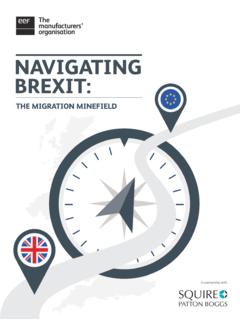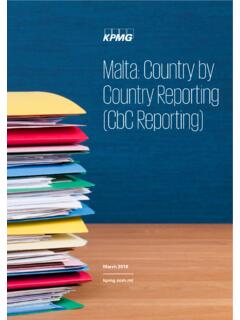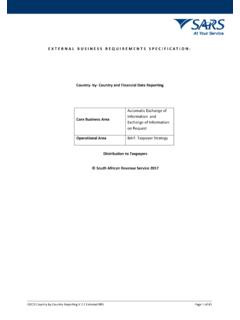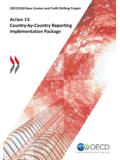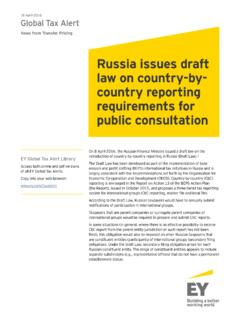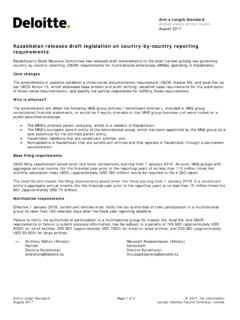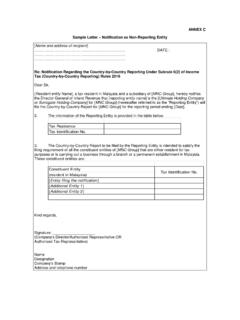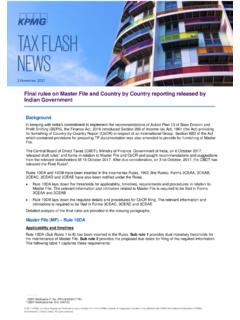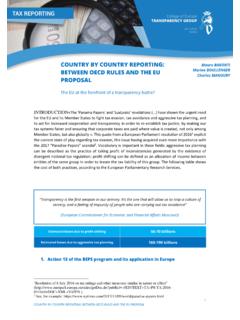Transcription of Action 13: Country-by-Country Reporting; Are You …
1 United StatesOn December 18, 2015, the United States Treasury (Treasury) issued proposed regulations to require CbyCR for US persons that are the ultimate parent entity of a multinational enterprise group. The first thing to note is that Treasury obviously believes it already has statutory authority to implement CbyCR via regulations. The key provisions of these proposed regulations are as follows:1. The US will use the model template issued by the OECD in the final BEPS 2. The US may exchange CbyCR information with countries where the US person operates, provided the US has reciprocity provisions in place with that jurisdiction. 3. CbyCR only applies to US persons who have US$850 million or more in group revenues, which isn t quite the same, but is generally aligned with the OECD s threshold of 750 The regulations will become effective for tax years beginning after the date on which the regulations are finalized.
2 Therefore, at least for calendar year enterprises, US CbyCR will be effective no sooner than for tax years beginning on or after January 1, 2017, with filing to be completed sometime in 2018. Strikingly, by effectively proposing filings to be completed in 2018 (for tax years beginning on or after January 1, 2017), Treasury might have made it possible that US-based MNEs that are not required to comply with US CbyCR requirements with respect to tax year 2016 will face requests for their 2016 CbyCR information from other countries. According to high-ranking officials at Treasury, Treasury recognizes the potential difficulties this would bring and are working assiduously with various countries in the hopes of coming to a collaborative solution that in effect serves as a patch for US-based MNEs.
3 This might be done in the context of the individual agreements with each Competent Authority as described in the preamble to the proposed regulations. Bob Stack, US Deputy Assistant Treasury Secretary for International Tax Affairs, recently emphasized that the US intends to enter into such bilateral agreements with appropriate countries that have also adopted Country-by-Country reporting provisions, have appropriate safeguards and infrastructure in place, and with respect to which the US has an income tax treaty or tax information exchange agreement in effect. That means a very large number of bilateral agreements must be entered into in a relatively short period of time even with the delayed US effective date of 2017.
4 3 The model template is available at: October 5, 2015, the Organisation for Economic Co-operation and Development (OECD) released a final package of 15 Action items (the Actions) as part of its years long work on the Base Erosion and Profit Shifting (BEPS) Project for the comprehensive, coherent and coordinated reform of the international tax rules. In November 2015, the G-20 endorsed the 15 Actions and now, where applicable, the Actions are awaiting implementation within the legislative and regulatory bodies of each participating amongst the 15 Actions is Action 13: one of the Actions intended to be implemented most quickly. Action 13 calls for a three-tiered standardised approach to transfer pricing documentation.
5 Specifically, Action 13, when implemented, requires all multinational enterprises (MNEs) to prepare both a master file providing a high-level overview of their global operations and a local file of transfer pricing documentation specific to each country relevant to its tax return. In addition, companies with consolidated group revenue equal to or exceeding 750 million will need to prepare a Country-by-Country report to summarize by jurisdiction revenue, pre-tax income, income tax paid and accrued, employees, stated capital, retained earnings, and tangible assets. Action 13 recommends that countries require Country-by-Country reporting (CbyCR) beginning for the 2016 tax year, with those initial reports being filed in 2017.
6 The report for Action 13 includes draft legislation, which countries may use to implement these new requirements, and also a model template detailing the information that the OECD recommends be reported. Several countries have taken steps to begin implementation of CbyCR over the past few months and we expect this trend to continue and accelerate. In addition, the European Commission (EC) has indicated it believes an EC version of CbyCR is appropriate in addition to the CbyCR regimes its member states will enact as part of BEPS. Indeed, on January 28, 2016, the EU released a proposal that a prior directive be expanded to require mandatory automatic exchange of Country-by-Country reports between Member states, 1 which contemplates some level of public disclosure of CbyCR information.
7 It should be noted, however, that any such directive by the EC will require unanimous approval by all EU member countries in order to become effective and, of course, it would be limited to MNEs that operate within the EU. In this Alert, we provide a Country-by-Country overview of CbyCR implementation progress to date in the following jurisdictions: The United States, Australia, China, France, Germany, Ireland, Netherlands, Poland, Spain, and the United 1 The proposal is available at: In addition to contributions from authors at Squire Patton Boggs, we acknowledge the kind contributions of Mark O Sullivan at Matheson Ormsby Prentice for his insights into CbyCR implementation in Ireland and of Cees-Frans Greeven at Buren Legal for his insights into CbyCR implementation in the 13: Country-by-Country reporting ; Are You Ready?
8 Meanwhile and not surprisingly on Capitol Hill, even prior to the release of the regulations, lawmakers questioned Treasury s authority to implement CbyCR under existing US tax law and raised concerns about implementation especially regarding privacy. In fact, on December 18, 2015, House Ways and Means Committee Member Charles Boustany (R-LA) introduced the BEPS Act ( 4297) to impose certain requirements on the Secretary of the Treasury relating to transmittals of Country-by-Country reports for purposes of the Base Erosion and Profit Shifting Action Plan. Specifically, the proposed legislation would: (1) prevent Treasury from collecting or transmitting CbyCR information from any US person for taxable years beginning before January 1, 2017; (2) suspend transmittal of CbyCR information to any jurisdiction that has been found to be abusing the master file document requirements or failing to safeguard the confidentiality of the CbyCR information, and (3) in some ways limit the information that can be requested in a CbyCR.
9 The interplay between current and forthcoming legislative efforts on CbyCR and Treasury s preferred path forward is far from certain, especially considering that the Senate has yet to offer companion legislation to Mr. Boustany s proposal. For these and other reasons ( , the upcoming 2016 election season), we believe Treasury will be well-positioned to timely implement the CbyCR rules in the Australia has agreed to adopt CbyCR for MNEs with group revenues over AU$1 billion, which happens to be significantly below 750 million at present. This requirement will apply to the reporting entity s tax years beginning on or after January 1, 2016, with reports due within 12 months of the end of the taxable year.
10 So far, Australia has not determined what its CbyCR format will look like, although in December 2015 the Australian Taxation Office noted that [t]he approved form for the statements corresponding to the CbC report and master file will include the information outlined in Annexures III and I of the OECD guidance. In the case of the CbC report, the approved form will be the OECD specified CbC XML schema. The CbC report will require information about the multinational group s income, taxes and business activities sorted by tax jurisdiction. The Australian Taxation Office (ATO) recently signed a multilateral agreement in Paris agreeing to share tax information of MNEs with other jurisdictions that are parties to the multilateral agreement.

